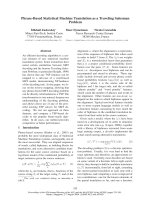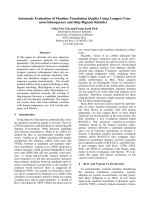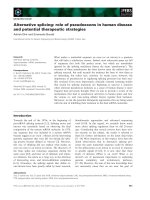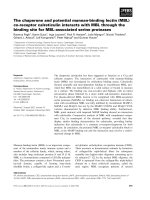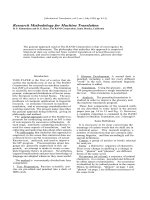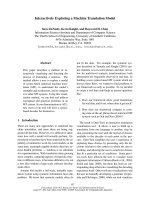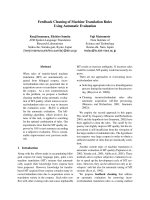Báo cáo khoa học: " The Work on Machine Translation in the Soviet Union" pot
Bạn đang xem bản rút gọn của tài liệu. Xem và tải ngay bản đầy đủ của tài liệu tại đây (136.84 KB, 6 trang )
[
Mechanical Translation
, vol.5, no.3, December 1958; pp. 95-100]
The Work on Machine Translation in the Soviet Union *
Fourth International Congress of Slavicists Reports, Sept. 1958
V. Yu. Rozentsveig, First Moscow State Pedagogical Institute of Foreign Languages, Moscow, USSR
Problems of machine translation have been
investigated in the Soviet Union since 1955.
1
A
number of groups are carrying out theoretical
and experimental work in the area of machine
translation.
In the Institute of Precision Mechanics and
Computer Technology of the Academy of
Sciences of the USSR (ITM and VT) dictionaries
and codes of rules (algorithms) have been com-
piled for machine translation from English, Chi-
nese, and Japanese into Russian; and a German-
Russian algorithm is being worked out. Experi-
mental translations of individual passages have
been made.
2
In the work of the ITM and VT
group there is a marked striving for the rapid
achievement of immediate, practical results.
The efforts of this group are directed not so
much toward a theoretical comprehension of
the general problem of machine translation as
toward a careful, detailed investigation of lin-
guistic material, especially lexical. Diction-
ary routines, routines for analysis of the sen-
tence in the source language, and routines for
the synthesis of the sentence in the target lan-
guage are being compiled in the ITM and VT on
the basis of traditional methods of describing a
language.
* Translated by Lew R. Micklesen, Depart-
ment of Far Eastern and Slavic Languages and
Literature, University of Washington, De-
cember 1958.
1. The idea of machine translation was advanc-
ed even in the 30's by the inventor-technician,
P. P. Smirnov-Troyansky.
An essentially different course is being fol-
lowed by the group working in the Steklov Mathe-
matical Institute of the Academy of Sciences
(MIAN). The problem of machine translation is
being examined here as part of the larger prob-
lem of the automation of thought processes. The
directors of this group regard the effective prac-
tical realization of machine translation only as
the result of profound theoretical research in
the area of mathematics and linguistics.
In MIAN three algorithms have been elabo-
rated: French-Russian, English-Russian, and
Hungarian-Russian.
3
During the compilation of
the first of these algorithms in 1955-56, the
workers in this group proceeded empirically,
i. e. they extracted the rules for the transla-
tion of each word from a comparative analysis
of French texts and their Russian translations.
In the elaboration of the English-Russian algo-
rithm, the MIAN group posed for themselves
a more complex problem determination of
the correspondences between the grammatical
structures of two languages. The posing of
such a problem was partially conditioned by the
nature of the relationships of the English and
Russian languages: although it was possible to
build the analysis of a sentence on a morpholo-
gical basis in translating a French mathematical
text into Russian, such a method did not seem
rational to the MIAN group in the case of Eng-
lish-Russian translations of similar texts. The
problem was also partially conditioned by the
theoretical goal of the director of the group.
Professor A. A. Lyapunov: to work out strictly
formal methods of describing languages in or-
der to attain gradual automation of the whole
process of machine translation.
2. I. K. Bel'skaya, "Concerning Certain Gen-
eral Problems of Machine Translation," Ab-
stracts of the Conference on Machine Transla-
tion, Moscow, 1958, pp. 10-14, (hereafter re-
ferred to as Abstracts CMT).
3. See O. S. Kulagina and I. A. Mel'chuk, "Ma-
chine Translation from French to Russian, " Vo-
prosy Yazykoznaniya, 1956, No. 5; T. N. Mo-
loshnaya, "Some Problems of Syntax in Connec-
tion with Machine Translation from English to
Russian, "Voprosy Yazykoznaniya, 1957, No. 4.
96 V. Yu. Rozentsveig
The theoretical basis for the isolation of typi-
cal sentence structures was the concept of the
syntagma (according to de Saussure) or of the
construct (according to Fortunatov). Machine
translation, however, requires a certain modi-
fication of this system. In the structural syn-
tactic analysis proposed by the author, T. N.
Moloshnaya, of the English-Russian algorithm
worked out at MIAN, constructs consisting not
only of two members but also of many members
(constructions with an absolute participle, etc.)
are isolated. Such elementary structures were
called configurations. They are composed of
words classified according to formal signs.
The analysis consists in reducing each configu-
ration to its basic word, that is, shortening it.
In this way, syntactical links are established be-
tween the words of a sentence. Synthesis of the
Russian Sentence is made by means of substitut-
ing for it a given English configuration which
corresponds to the Russian configuration and
completing it with Russian words on the basis
of the data of the dictionary, more precisely, of
the Russian part of the dictionary, and on the
basis of the corresponding morphological rules.
The dictionary for machine translation, as com-
piled at MIAN during work on the French-Rus-
sian algorithm consists of two parts: (1) the
foreign, containing the words of the given lan-
guage (more precisely their stems, i.e. the
graphically invariable parts of a word) with their
corresponding tags indicating part of speech, id-
iomatic relationships, government by preposi-
tion and grammatical characteristics and (2),
the Russian, containing Russian stems and the
corresponding information about them. The Rus-
sian part of the dictionary is independent of the
foreign part; so it may be used in translating
from various languages. The rules for the mor-
phological form of a Russian word are also inde-
pendent of the language from which the transla-
tion is made.
The significance of the MIAN English-Russian
algorithm lay in the fact that in contrast to all
preceding algorithms in which the analysis of
the text under translation was realized in terms
of a translation into Russian (a category of the
Russian language was ascribed to a foreign
word), in T. N. Moloshnaya's algorithm the
structural-grammatical analysis of an English
sentence proceeded, in principal, independently
of the language into which the text was being
translated. This is extremely important, for
an independent analysis opens the way for the
realization of machine translation not only from
one concrete language to another, but also from
many languages to many others.
Several scientific groups are now working a-
long this path opened up by the efforts of the
MIAN Group. In the division of applied linguis-
tics of the Institute of Linguistics of the USSR
directed by A. A. Reformatsky, rules for the
analysis and synthesis of a text and an abstract
system of lexical and syntactic correspondences
between various languages are being worked out
independent of a translation into a concrete lan-
guage by I. A. Mel'chuk. All of this should al-
low us to do machine translation from several
languages into several other languages (the mod-
el of such an intermediary language is being
made on the basis of an analysis of Russian,
English, Chinese, French, and Hungarian).
Syntactic analysis lies at the basis of the trans-
lation system being developed by I. A. Mel'
chuk — morphological data are employed only as
auxiliary data in the establishment of configura-
tions, i.e. in bringing out the relationships be-
tween words in the source language and the ex-
pression of these relationships by means of the
target language.
In this connection one should mention the re-
search on the isolation and cataloguing of the sys-
tem of relationships in the Russian language car-
ried out in close collaboration with I. A. Mel'chuk
in the Laboratory of Electrical Modelling of the
Ail-Union Institute of Scientific and Technical
Information of the State Scientific-Technical
Committee in the Soviet of Ministers of the USSR
and of the Academy of Sciences of the USSR(LE).
In Russian mathematical texts the workers of this
laboratory, Z.M. Volotskaya, E. V. Paducheva,
I. N. Shelimova, and A. L. Shumilina isolated and
described about 200 syntagmas (two-membered
constructs in a subordinate relationship) which
are essential in both the analysis and the syn-
thesis of a Russian sentence.
A substantial contribution to the theory of
translation algorithms and their programming
was made by O.S. Kulagina (MIAN). She de-
veloped a system of so-called elementary oper-
ators of the simplest steps of which any trans-
lation process may consist and of programs cor-
responding to these steps. As a result, signifi-
cant generalization and standardization in the
process of making algorithms can be attained,
all of which allows us to pose the problem of
automation of the programming of algorithms
and then the problem of their automation and
construction.
MT in the Soviet Union 97
The Experimental Laboratory of Machine
Translation of the Leningrad State University
(ELMP) under the directorship of N.D.Andreyev
is also endeavoring to realize the idea of develop-
ing completely independent methods of analysis
and synthesis and of some abstract logical sys-
tem making it possible to go from analysis to
synthesis, i.e. a system that will serve as an
intermediary language. In this laboratory ex-
tensive material from various linguistic sys-
tems is being investigated; Indonesian-Russian,
Arabic-Russian, Japanese-Russian, Burmese-
Russian, Norwegian-Russian, English-Russian,
Spanish-Russian and Turkish-Russian algorithms
are being developed. The intermediary lan-
guage which N. D. Andreyev is attempting to
create is an artificial language constructed by
averaging the phenomena of various languages.
It is regarded as a material language with its
lexicon, its morphology, and its syntax, but
with the one peculiarity that it consists of sym-
bols *. In the selection of the categories at the
basis of his symbolization, N. D. Andreyev con-
siders the most frequent phenomena and also
the international prestige of each language.
4
The system of signs developed in ELMP for
the recording of the intermediary language can
be used also for the recording of information in
information machines.
Along with work on the algorithms of machine
translation from foreign languages into Russian
and from Russian into foreign languages being
conducted in the Gorki State University, the fol-
lowing algorithms are being elaborated: Arme-
nian-Russian and Russian-Armenian (in the Com-
putation Center of the Academy of Sciences of
the Armenian SSR), Georgian-Russian and Rus-
sian-Georgian (in the Institute of Automation
and Telemechanics of the Academy of Sciences
of the Georgian SSR).
In the First Moscow State Institute of Foreign
Languages (I MGPIIYa) where under the direc-
torship of I.I.Revzin theoretical investigations
of the problems of machine translation and of
related problems of linguistic theory of trans-
lation and methodology of foreign language teach-
* Translator's note: The author obviously
means symbols different from the conventional
symbols of language.
4. N. D. Andreyev, "Machine Translation and
the Problem of an Intermediary Language," Vo-
prosy Yazykoznaniya, 1957, No. 5.
ing have been carried out, the elaboration of
Russian-English, Russian-French, and Russian-
Spanish translation algorithms for foreign policy
texts has begun . At the Institute, the Machine
Translation Society has been created at whose
meetings theoretical problems are discussed
and an exchange of ideas about the practical
problems of the compilation of the algorithms
takes place. In the bulletin published by the So-
ciety are published both theoretical and experi-
mental work connected with the problem of ma-
chine translation. In May, 1958, the Society
convened the First All-Union Conference on Ma-
chine Translation. Seventy-nine institutions
were represented at the conference, including
twenty-one institutes of the Academy of Sciences
of the USSR and eight institutes of the Academies
of Science of the Union Republics, eleven univer-
sities, and nineteen other institutions of higher
learning in the country. Linguists, mathemati-
cians, and technicians took part in the work of
the conference. At the plenary and sectional
meetings of the conference there were discus-
sions of more than seventy reports and communi-
cations devoted to general linguistic problems
arising in connection with the use of language in
present-day automatic devices as well as to spe-
cial problems of construction of algorithms for
machine translation.
5
The central problem now confronting linguists
working in the field of machine translation is
that of the methods of formal description of lin-
guistic structures. Structural methods, parti-
cularly the methods elaborated by descriptive
linguistics, offer much of value for the formal
description of language — it was not by accident
that the work of Fries in the structure of the
English language proved useful in working out
English configurations. It has become clear,
however, that these methods are inadequate for
the formal description of language to the ex-
tent that this is demanded in automatic transla-
tion. In connection with this a search for means
of applying mathematical methods to the analys-
is of language was begun. With this in mind the
Department of Philology of the Moscow State Uni-
versity initiated a seminar on mathematical lin-
guistics in 1956, joining mathematicians and lin-
guists under the direction of P.S. Kuznetsov, V. V.
Ivanov, and V. A.Uspensky. Here, as well as at
the meetings of the Machine Translation Society
the idea, suggested by Academicians A. N.
Kolmogorov and A. A. Lyapunov, of applying
the methods of mathematical logic and of set
5. See Abstracts CMT, M., 1958
98 V. Yu. Rozentsveig
theory to the study of language was discussed.
Thus, for example, A. N. Kolmogorov's idea
about the possibility of a strict formal definition
of the category of case (the work of V.A. Uspens-
ky and, in part, also of R. L. Dobrushin) was
expounded and developed. It is interesting to
note that eight cases can be counted in the de-
clensional system of the Russian substantive
according to this definition.
A method for defining grammatical categories,
worked out by a student of Professor Lyapunov,
O. S. Kulagina (MIAN), was discussed at the se-
minar. This method of definition allows one to
obtain, independently of the concrete features
of the language, a classification of words and a
determination of their syntactic relationships.
Language in this conception is regarded as a
set of elements — words, or more exactly —
word forms. A finite number of words arrang-
ed in a definite order is called a sentence. Cer-
tain sentences are assumed to be marked —
these are sentences constructed according to
the norms of the given language — others are
unmarked. According to the criteria of mutual
substitutability of words in the marked sentences
the entire set of words is broken down into groups
of mutually equivalent words.
In terms of this system a series of definitions
corresponding, in general, to certain tradition-
al morphological categories, for example, parts
of speech, was successfully obtained. The ad-
vantage of this classification lies, however, in
the fact that it has been deduced on the basis
of an exact and strictly formal system of defi-
nitions. It is particularly effective for languages
with a rather symmetrical system of word forms
(for example, French). In languages like Rus-
sian that do not possess this symmetry, the
method of defining a grammatical category pro-
posed by R. L. Dobrushin can be utilized.
By making use of the criterion of equivalency,
the relationships between the classes of words
isolated are also determined. Moreover, the
concept of configuration, mentioned earlier,
gets a more exact definition: a configuration is
defined by O. S. Kulagina as that combination
of not less than two words belonging to various
non-intersecting subsets, which can be reduced
to one element without any marked sentence con-
taining this configuration losing its marked quali-
ty. Thus the combination of the words "thick
book" in the sentence "the thick book lies on
the table" can be reduced to the element "book"
or can be replaced by the element "thing" or
the element "it" without the sentence ceasing to
be marked. The isolation of the configurations
allows one to determine the syntactic structure
of the sentence.
The set-theory concept of language is strictly
deductive and formal. This is just what deter-
mines its importance both for general linguis-
tics and for machine translation. Naturally the
formal description of language is possible only
to a limited extent. Thus, the concept of the
marked quality of sentences, without which it
is impossible to determine the equivalence of
elements and configurations of a language, will
have little effect if it is extended to all function-
al areas of language. But in a limited sphere
of language — and machine translation at the
present time is being considered only within the
limits of scientific and technical prose — this
concept is sufficiently exact and effective. Thus,
all sentences in a given language which are met
in a given field of scientific literature can be
considered marked.
The set-theory conception of language is im-
portant in yet another respect. Since it allows
us to construct and investigate a grammatical
model, i.e. a simplified analog of actual lin-
guistic relationships, this theory opens one of
the possible ways for logico-semantic investiga-
tions of language. In this connection we should
point to the ideas of V. V. Ivanov about the pos-
sibility of applying mathematical methods to the
definition of the lexical meaning of words. I
note that, contrary to wide-spread opinion, the
theory of machine translation is not limited to
the investigation of language in its formal as-
pect alone. The search for methods of objective,
precise description of the system of meanings
in language has begun.
If it is true that complete formal description
of an actual language is hardly accessible, that
it is necessary to attain only formal approxima-
tions to actual language, then a statistical eval-
uation of the probability of this approximation
acquires special importance
6
. On the other
hand, certain phenomena of language do not
yield, for the time being, to structural descrip-
tion and can be formally described only statisti-
cally.
6. See V. A. Uspensky, "Conference on the
Statistics of Speech," Voprosy Yazykoznaniya,
1958, No. 1, p. 173.
MT in the Soviet Union 99
The quantitative aspect of linguistic phenomena,
both lexical and grammatical, has been consider-
ed, as a rule, in all the algorithms formulated.
One should point particularly to the statistical
investigations carried out on Russian language
material in the Laboratory of Electrical Model-
ing. I have already mentioned the cataloguing
of Russian syntagmas. This work was accom-
panied by a statistical investigation of the lan-
guage of Russian mathematical texts. The re-
sults of this work conducted by I. A. Mel'chuk,
T. N. Moloshnaya, A. L. Shumilina, Z. M.
Volotskaya, and I. I. Shelimova, were, along
with other works, announced at the conference
on the statistics of speech convoked in October
1957 by the Section of Speech of the Commission
on Acoustics of the Academy of Sciences of the
USSR and by Leningrad University. This work
is of interest not only in a practical respect.
Its value consists in a true solution to the prob-
lem of combining statistical and structural me-
thods: a count of linguistic elements was car-
ried out by the authors on the basis of a clear-
cut definition of such concepts as "syntagma",
"type of syntagma", etc. As I. I. Revzin show-
ed in his report presented at the conference
mentioned, the correlation of structural and
statistical methods has a two-sided nature: sta-
tistics aids in specifying the structure of lan-
guage and an exact structural definition of units,
the number of which are counted, insures the
proper conduct of the statistical investigation.
A frequency count of dictionary units is im-
portant not only in connection with machine
translation. No longer speaking about statisti-
cal investigations of problems of general and
particular linguistics
7
, which have already be-
come traditional, we shall point to recent works
connected with the use of language in various
devices for the storage, processing, and trans-
mission of information. In reference to the Rus-
sian material we can call attention to the use of
methods of machine translation for the coding
of telegraphic and telephonic messages.
It has been established (V. I. Grigor'ev and
G. G. Belonogov) that the size of a telegraph
message in Russian can be diminished by 3-4
times if the telegraphic communication is trans-
lated from a letter code into a dictionary (lexi-
cal) code. Statistical investigations have shown
that in the case of such coding 4, 000 common
words would be sufficient in order to insure the
transmission of 97.5 percent of a general-lan-
guage text.
The problem examined here is connected, for
the most part, with an analysis of the text under
translation. For the Soviet specialists the ela-
boration of effective methods for analysis pre-
sented special difficulties: they dealt primari-
ly with morphologically poor languages. It
would be erroneous, however, to assume that
the synthesis of the Russian sentence did not
present any serious difficulties to them. By
way of illustration we may cite the difficulties
arising in the synthesis of Russian aspectual
forms, inasmuch as the category of aspect per-
meates the entire Russian verbal system.
Here two problems of principle arise. In the
first place, it is necessary to find a principle
of classification of Russian verbs which will al-
low us to obtain for each verb in an absolutely
regular way (by adding or taking away the same
letters) all forms of the perfective as well as of
the imperfective aspect. Such work was done by
Z. M. Volotskaya (LE), who obtained three break-
downs of the whole Russian verbal complex ac-
cording to method of formation: a) of present
tense forms; b) of past tense forms; and c) of
the perfective stem from the imperfect stem.
8
In the second place — and this task is much
more difficult — it is necessary to work out the
rules for the choice of one or the other aspectu-
al form. Inasmuch as the tendency towards car-
rying out the operations of synthesis independent-
ly from those of analysis has already been noted,
these rules must be constructed on the basis of
contextual data, considering, for example, the
presence in the sentence of adverbs, the charac-
ter of the combination, etc. In a series of cases
one must limit oneself only to a probable solu-
tion, based on statistics.
The problem of machine translation from Rus-
sian, of course, occupies Soviet investigators
less than the problem of translation into Russian.
But investigative work connected with the analy-
sis of the Russian sentence has already begun
(chiefly in the Laboratory of Electrical Modeling,
the Division of Applied Linguistics of the Insti-
tute of Linguistics of the Academy of Science of
the USSR and in ITM and VT). From the point
of view of general linguistics the work reveal-
7. In this connection one should recall the
works in the statistical investigation of Russian
literary works, carried out in the 20's and 30's
by A. I. Peshkovsky, M. Peterson, et al.
8. See Abstracts CMT, p. 87
100 V. Yu. Rozentsveig
ing the redundancy of certain categories of the
Russian language is most interesting. Thus,
for example, the category of gender in the Rus-
sian verb, expressed only in the forms in -1 of
the singular of the past tense and of the condi-
tional mood, is redundant, unnecessary from
the standpoint of analysis. It is clear (V. N.
Vinogradova, the Institute of Linguistics of the
Academy of Science of the USSR) that in scienti-
fic texts the number of verbs with the expressed
form of gender comprises from four to thirty per-
cent and that in the majority of sentences the
verb can be related only to the subject — the
only substantive in the nominative case. Nor is
it necessary, in most cases, to consider the in-
flection of the Russian adjective and determine
the relationships of the adjective to the substan-
tive with which it agrees on the basis of the po-
sition of the adjective in the sentence. (N. N.
Leont'eva and G. H. Vavilova, the Institute of
Linguistics).
Interesting also is the work on the determina-
tion of syntactic links for the preposition-case
groups of the Russian language (I. N. Shelimova)
and also the work on the elaboration of the syn-
tactic links for formulas in Russian mathemati-
cal texts (M. M. Langleben) — by formulas the
author means all elements not found in the ma-
chine dictionary during the processing of the text
(mathematical formulas, foreign-language cita-
tions, surnames, etc.)
For the analysis of a Russian sentence it is
necessary to characterize the marks of punctu-
ation. Only in such a way can one find the lim-
its of a simple clause within a sentence, isolate
its similar members, aid the further clarifica-
tion of the co-relationships of the individual
parts of a sentence with complex punctuation, de-
termine a group of similar members. T. N.
Nikolayeva (ITM and VT) conducted an analysis
of polysemantic marks of punctuation (comma,
dash, colon) in Russian
9
.
Thus the realization of machine translation
presupposes serious theoretical investigations,
which, in turn enrich the problems of general
and applied linguistics.
9. See Abstracts CMT, pp. 104-107

